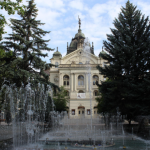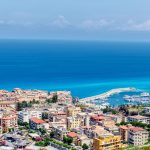Calabria was a key region of Magna Graecia, shaped by Greek settlers who arrived on the shores of Southern Italy in the 8th and 7th centuries BC. These pioneers from the Peloponnese established coastal cities that evolved into a network of booming economic centers. Attracted by fertile lands and strategic trade routes, the Greeks brought their language, art, and philosophy, making an impact that would greatly influence the Roman world and beyond.
The Romans later named this area “Magna Graecia,” or Great Greece, reflecting its significance. In Calabria, ancient cities such as Kroton, Locri, and Rhegion emerged as hubs of wealth and innovation, excelling in philosophy, athletics, and medicine.
Today, the remnants of this illustrious past are scattered across Calabria, and the Magna Graecia origins of the region are very much kept alive in the public consciousness (see the Magna Graecia Film Festival, for example). As you travel the region, you can’t help but feel a connection to this ancient past.
Continue reading to find out about some must-visit ancient sites in Calabria. If you would like to explore the region with the company of knowledgeable local guides, book a place on one of our Small Group Tours in Calabria.

Coastal Treasures of Magna Graecia
Calabria’s stunning coastal regions were among the first areas in Italy to be settled by Greek colonists. These early settlements blossomed into significant hubs of culture, religion, and commerce.
The strategic site of Cape Taurean (Capo Taureano), close to present-day Palmi, showcases the remnants of ancient Greek settlements and sanctuaries. This coastal location, linked to ancient Rhegion (modern Reggio Calabria), offers panoramic views of the Tyrrhenian Sea and serves as a reminder of its historical importance as a maritime outpost.

Along Calabria’s Ionian coast, the city of Locri emerged as a key player in Magna Graecia, thanks to its fertile lands and advantageous positioning. The city is steeped in deep religious significance, particularly noted for the Sanctuary of Persephone, which was a crucial site of worship. Today, the Archaeological Park of Locri Epizefiri preserves the vestiges of ancient walls, temples, and inscribed terracotta tablets detailing early Greek laws.
Cumae, although located outside Calabria, played a foundational role in Greek colonization. As the first Greek settlement on the Italian mainland, it established trade networks and cultural ties that extended deep into Calabria. Its influence reached Neapolis (modern Naples) and contributed to the interconnectedness of Magna Graecia.

Centers of Knowledge and Power
The cities of Magna Graecia served not only as bustling places of commerce but also as vibrant centers for intellectual, sporting, and medical advancements. Their influence reached far, far beyond their borders.
Among the most renowned of these cities was Kroton (modern-day Crotone), celebrated for its philosophical and athletic legacy. Here, the esteemed philosopher Pythagoras established a school that intricately wove together mathematics, science, and ethics, attracting disciples from across the Mediterranean.

The city also gained fame through its remarkable athletes, such as Milo of Croton, who is regarded as one of antiquity’s greatest competitors, and Astylos of Croton, a decorated Olympian. The Sanctuary of Hera Lacinia, majestically situated on the promontory of Capo Colonna, further exemplifies the city’s rich religious heritage and architectural prowess.
Nearby, Thurii (also known as Thurium by later Latin writers) drew the attention of Herodotus, known as the “Father of History,” who chose to settle there, enticed by its scholarly atmosphere. With a thoughtfully designed urban layout reflecting Greek ideals of order and harmony, Thurii was a testament to the pursuit of both intellectual and aesthetic excellence within its community. However, Thurii was not even the first significant city established at this location; Thurii was built on the ruins of the older city of Sybaris (founded in 720 BCE and destroyed in 510 BCE).
Sybaris earned a reputation for its extraordinary wealth and refinement. Located in the fertile plains of Calabria, the city’s prosperity stemmed from agriculture and trade, supported by its strategic position between the Ionian and Tyrrhenian coasts. This cultural and economic success gave rise to the term “sybaritic,” which denotes luxury and indulgence. Although Sybaris was destroyed and rebuilt multiple times, it influenced the founding of Poseidonia (modern Paestum), extending its legacy to other parts of Magna Graecia.
Today, the remains of these cities provide insight into their former grandeur. From the structured streets of Thurii to the ruins of Sybaris and the sanctuary at Kroton, history buffs will be in seventh heaven as they travel across Calabria and its surrounding regions.

Preserving the Greek Legacy in Calabria
The legacy of Magna Graecia is preserved not only in the ruins of ancient cities but also in the museums and cultural sites of Calabria.
Reggio Calabria, known in antiquity as Rhegion, was one of the oldest and most influential Greek colonies in Magna Graecia. Today, the city is home to the National Archaeological Museum of Magna Graecia, which houses one of Italy’s most significant collections of ancient Greek artifacts. Its centerpiece is the Bronzes of Riace, two full-size Greek warrior statues dating back 2,500 years. These masterpieces exemplify the skill of Greek sculptors and remain among the finest examples of ancient bronze art in the world.
The Archaeological Park of Locri Epizefiri, located near the modern town of Locri, offers a detailed glimpse into life in a Greek colony. Among its highlights are the remains of the Sanctuary of Persephone, terracotta plaques inscribed with early Greek laws, and other structures that illustrate the city’s role as a religious and cultural center. Locri was also known for its codified laws, making it one of the earliest cities to formalize governance in the Greek world.

In the small coastal town of Monasterace lies the Archaeological Museum of Ancient Caulonia, which showcases artifacts from the once-thriving city of Caulonia. Renowned for its pottery, mosaics, and statuettes, this site provides insights into the daily lives of its inhabitants. The museum’s collection highlights the artistic and commercial connections between Greek colonies in Calabria and other parts of the Mediterranean.

At the Scylletium Archaeological Park, near modern Catanzaro, visitors can explore the remains of a Greek settlement that later became a Roman city. Scylletium offers a fascinating perspective on the transition from Magna Graecia to Roman rule, with its amphitheater, temples, and other structures revealing the layered history of this coastal site.
In Catanzaro, guests will also note that there’s an annual Magna Graecia Film Festival. Although not strictly related to anything ancient, it’s a nice example of how the region’s Magna Graecia origins are well-known and constantly hearkened back to.
A Living Legacy of Magna Graecia
Magna Graecia’s influence endures not only in ancient ruins but also in Calabria’s living traditions, most notably through the Griko-speaking communities. These villages, located in parts of Reggio Calabria and Apulia, preserve a language that blends ancient Doric Greek, Byzantine Greek, and Italian elements. Griko is spoken by a dwindling number of residents but continues to reflect Calabria’s deep historical connections to the Greek world. The Greek influence is also a constant, background presence in the folk songs and dances of southern Italy.
If you love history, there’s simply nowhere better to visit than Italy! Join us on a Guided Tour of Calabria or a Tour of Sicily and feel the magic of these places for yourself. Or, perhaps you have your own family connections to this land? If so, one of our Private Heritage Tours in Southern Italy could help you reconnect to places important to your family story.
If you have any questions about our tours and services, please get in touch.








